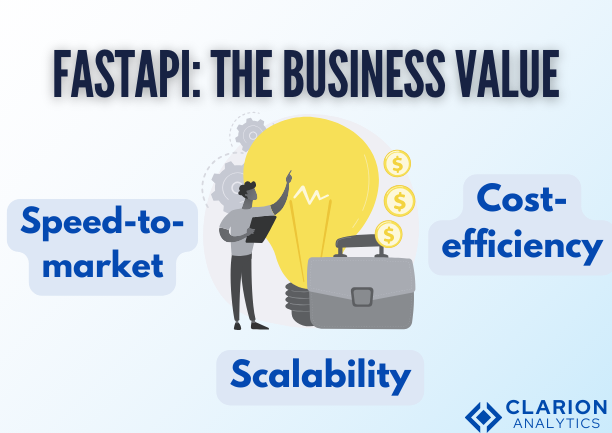
Introduction
FastAPI is rapidly gaining popularity as one of the most efficient, fast, and developer-friendly frameworks for building APIs. Its combination of speed, scalability, and simplicity makes it a top choice for developers and businesses alike. For software developers, It offers rapid development cycles, async capabilities, and built-in validation that reduces debugging time. For CXOs, its cost-efficiency, scalability, and support for long-term ROI present a strategic advantage for businesses looking to launch products faster and scale effortlessly.
The Evolution of API Frameworks
- Traditional API Frameworks: Challenges and Bottlenecks
Older frameworks like Flask and Django, while popular, have faced scalability and performance bottlenecks, particularly when handling large numbers of requests or asynchronous operations. Flask, while lightweight, requires additional setup for key features like validation, while Django’s all-in-one approach can sometimes slow down API development with unnecessary overhead.
- The Shift to FastAPI: Speed, Performance, and Simplicity
It has emerged as a revolutionary alternative, designed to resolve these challenges. With asynchronous support, automatic interactive documentation, and seamless input validation, it offers a more efficient solution for modern API development. It is built on Python 3.6+ type hints, which allows developers to write less code while maintaining clarity and reliability.
Why FastAPI is Different
At its core, It uses Python’s async capabilities, type hinting, and automatic interactive API documentation (Swagger, ReDoc). This combination enhances productivity by minimizing boilerplate code and providing easy-to-use validation tools.
- Asynchronous Requests for Improved Performance: handles multiple requests concurrently, increasing the throughput for API endpoints.
- Automatic Documentation with Swagger and ReDoc: generates interactive documentation automatically, making it easier for both developers and CXOs to visualize API workflows.
- Type Hints and Input Validation: By leveraging Python’s type annotations, ensures robust data validation, reducing bugs and improving code reliability.
- Built-in Support for Dependency Injection: This feature helps scale and test applications by promoting cleaner, more modular code.

Speed and Performance
It’s performance benchmarks consistently outperform traditional frameworks like Flask and Django due to its async-first architecture. In production environments, It often results in fewer resources used to handle the same volume of traffic, making it more cost-effective and scalable.
FastAPI in Action: Building a High-Performance API
Step-by-step Guide to Setting Up
To start you’ll need Python 3.7+, pip, and a few dependencies:
pip install fastapi uvicornCreating Your First Endpoint
With just a few lines of code, you can define an API endpoint:
from fastapi import FastAPI
app = FastAPI()
@app.get("/")
def read_root():
return {"Hello": "World"}Handling GET and POST Requests Efficiently
simplifies handling HTTP requests, allowing for asynchronous processing:
@app.post("/items/")
async def create_item(item: Item):
return itemFastAPI for CXOs: The Business Value

- Speed-to-market: Launching Products Faster
It’s intuitive syntax and built-in features allow companies to bring new products and features to market quickly, giving them a competitive edge.
- Cost-efficiency in API Development
It’s asynchronous capabilities make it possible to handle more requests with fewer resources, reducing infrastructure costs and improving overall ROI.
- Scalability: Building APIs that Grow with Your Business
As your user base grows, It’s ability to scale efficiently ensures that performance remains optimal, avoiding common bottlenecks faced by traditional frameworks.
Advanced Features: Scaling and Optimizing Your APIs
- Using Background Tasks for Complex Workflows
It allows background tasks to handle time-consuming operations, freeing up the API to continue processing other requests.
- WebSockets and Real-time Applications
It supports WebSockets, enabling the development of real-time communication systems such as chat applications or live data streams.
- Caching with FastAPI for Performance Gains
By implementing caching mechanisms, you can significantly reduce server load and improve response times for frequently accessed data.

Challenges and Limitations
- Steep Learning Curve for Beginners
It’s asynchronous nature may pose challenges for developers unfamiliar with async programming or Python type hinting.
- Compatibility Issues with Older Libraries
Some older libraries do not fully support It’s async model, which can limit its integration with legacy systems.
- Managing Complex APIs in Large Applications
Managing dependencies and maintaining modularity in complex, large-scale applications can be a challenge.
FastAPI vs. Other API Frameworks
- Flask: When to Choose Which
FastAPI is ideal for performance-critical, scalable applications, whereas Flask’s simplicity makes it suitable for small, quick projects.
- Django: Full-stack vs. API-focused
Django is a full-stack web framework with a wider feature set, while FastAPI is optimized for building APIs with high performance.
- Express.js (Node.js): Python vs. JavaScript
For teams already using Python, FastAPI offers a streamlined API development experience with better performance than Node.js in some use cases.

source – christophergs
Future
- The Rise of Async-first APIs
In a world moving towards microservices and real-time data, It’s async-first approach is leading the charge for the next generation of APIs.
- Contribution to the Python Ecosystem
it is pushing the adoption of modern Python features, making asynchronous programming and type hints more common in the Python community.
Conclusion
FastAPI’s speed, scalability, and ease of use make it the go-to framework for modern API development. Whether you’re a developer looking to build high-performance applications or a CXO looking for long-term ROI, it has the tools and features to deliver results.
Intrigued by the possibilities of AI? Let’s chat! We’d love to answer your questions and show you how AI can transform your industry. Contact Us
